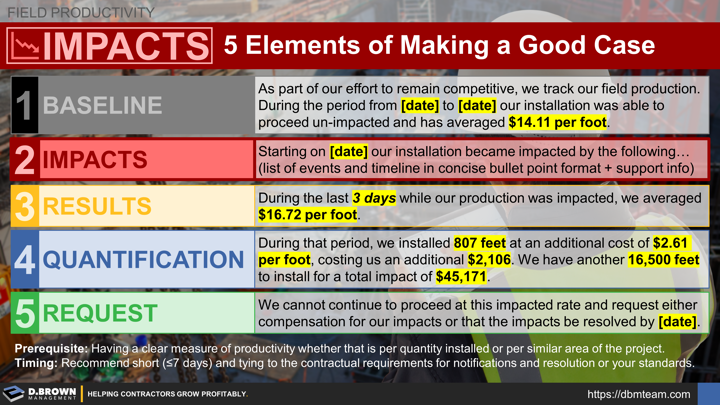Many of these impacts come from areas outside of their direct control but well within their areas of influence. The best Project Managers, Foremen, and Superintendents know how to continually expand their influence over these areas.
This influence starts with being able to make a good argument about the impact, including quantification and proposed resolution:
- Establish a clear and quantified baseline of where your production actually was before the impact. This is the foundation of your argument and critical if your argument escalates to any formal dispute resolution.
- Describe the impacts being specific and without any negative emotions. Provide supporting information including timeline, photos, communications, etc.
- Describe and quantify your impacted productivity since the impact(s) started. Never let impacts linger more than 3 days because the chances of correction diminish exponentially over time.
- Quantify the total estimated impact if the impacts are not corrected.
- Request a resolution providing specific suggestions if possible, including a sunset timeline on the request.
Always argue your case with integrity and never assume ill-intent from other parties because that will break down trust.
The initial communication, whether verbal, written, or both would be formatted in approximately the following flow:
- Baseline: As part of our effort to remain competitive, we track our field production. During the period from [date] to [date] our installation was able to proceed un-impacted and has averaged $14.11 per foot.
- Impacts: Starting on [date] our installation became impacted by the following: (list of events and timeline in concise bullet point format + support info)
- Results: During the last 3 days while our production was impacted, we averaged $16.72 per foot.
- Quantification: During that period, we installed 807 feet at an additional cost of $2.61 per foot, costing us an additional $2,106. We have another 16,500 feet to install for a total impact of $45,171.
- Request: We cannot continue to proceed at this impacted rate and request either compensation for our impacts or that the impacts be resolved by [date].
Prerequisite: Having a clear measure of productivity, whether that is per quantity installed, per similar area of the project, or Percent Planned Complete (PPC) on Short-Interval Plans (SIPs).
Timing: Recommend short duration of 1-7 days for both the identification of the initial impact to productivity as well as the request for resolution. This should be tied back to the contractual terms where applicable and to your company standards when it is not explicitly spelled out in the contract documents.
Escalations: Ensure that impact notifications like this are escalated to the right person inside your company and the customer's company.
Perspective: Remember that there are likely multiple perspectives on these impact events or conditions as well as the resulting productivity impact. Ask "Good Questions" to better understand everyone's perspective which will help you make your case even stronger including working toward a fair resolution.
Contact us to learn more by scheduling a workshop and roadmap facilitation session on labor productivity, change management, and developing from a Project Manager into a Business Manager.
Additional Resources for Negotiating
These resources in this order are worth going through with your team in the context of how to apply them to negotiations at the project level. An experienced and unbiased 3rd party facilitator can help tie these concepts to practical application for a contractor.
- Trust is the foundation that all negotiations are built upon - know how to build it and ensure that a trusting relationship is in place at all levels between your company and the customer well before the first negotiation of an impact needs to take place.
- Never Split the Difference (Audible)
- Start With 'NO' (Audible)
- Ask for More (Audible)
Contact us for a learning guide that you can use with your team tied to these resources.

